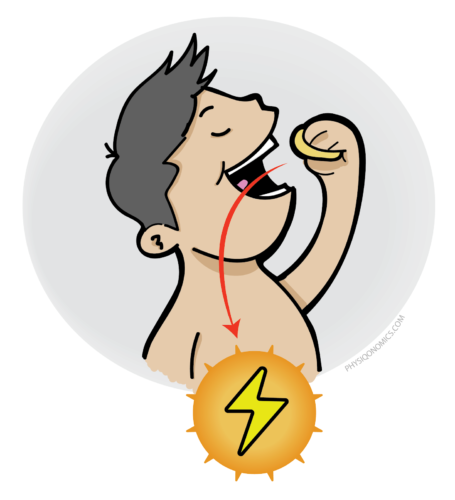Understanding Metabolism
November 17, 2021

It is very likely you have heard the word metabolism used somewhere.
Metabolism is usually used around weight loss, and the first association of the word is most likely in a phrase like “He has a slow metabolism”, or “I must have a fast metabolism, I eat whatever I want and never gain weight”.
What actually is metabolism though? It is a very common word in the fitness world with not a lot of understanding around it.
To put it simply, metabolism or metabolic rate is the total energy expenditure of the body. It is the sum of every reaction and process taking place within the body. Every bodily function requires energy, and everyone’s metabolic rate is different. You and your friend could be very similar in height, weight, be doing the same amount of exercise and eating the same diet but still experience a very different rate of weight loss. This is because of the difference in metabolism. Your metabolism is unique to you.
The sum of this energy expenditure is measured in calories, essentially meaning that the measurement of metabolism is how many calories a person will burn in one day.
As already mentioned when people discuss metabolism it is normally in regards to weight loss or gain. It is true that having an increased metabolism will help with weight loss, the goal for people aiming to burn fat is to increase their metabolic rate, as such so they are to burn more calories than they are taking in.
How can you increase your metabolism?
Your total daily energy expenditure is made up of three components.
1. Resting Metabolic Rate (RMR) (60-70%)
Lean muscle is a major factor in RMR, the more muscle a person has the higher their resting metabolic rate will be, to increase your metabolism your goal in training should be to increase muscle mass through strength and resistance training.
2. The Thermic Effect of Food (TEF) (10%)
The TEF is the energy cost required to process foods. Protein has a much higher thermic effect than carbohydrates and fats. Meaning, we can potentially increase our metabolism (without changing total calorie consumption) by increasing our protein intake and reducing our carbs and fats.
3. Physical Activity Induced expenditure. (20-30%)
This is the easiest part to understand, and also why you see the prescription and importance of exercise (and an increase in non-exercise activity) to help with fat loss. In a nutshell, the more you move the more calories you will burn. The type of exercise matters though. With lean muscle being such an important part of RMR it is important for an exercise prescription to have the purpose of increasing activity levels and increasing muscle mass. This is why resistance training is such an important inclusion in every exercise plan, aiming to build muscle to help burn fat.
Share This Story, Choose Your Platform!
Understanding Metabolism
November 17, 2021

It is very likely you have heard the word metabolism used somewhere.
Metabolism is usually used around weight loss, and the first association of the word is most likely in a phrase like “He has a slow metabolism”, or “I must have a fast metabolism, I eat whatever I want and never gain weight”.
What actually is metabolism though? It is a very common word in the fitness world with not a lot of understanding around it.
To put it simply, metabolism or metabolic rate is the total energy expenditure of the body. It is the sum of every reaction and process taking place within the body. Every bodily function requires energy, and everyone’s metabolic rate is different. You and your friend could be very similar in height, weight, be doing the same amount of exercise and eating the same diet but still experience a very different rate of weight loss. This is because of the difference in metabolism. Your metabolism is unique to you.
The sum of this energy expenditure is measured in calories, essentially meaning that the measurement of metabolism is how many calories a person will burn in one day.
As already mentioned when people discuss metabolism it is normally in regards to weight loss or gain. It is true that having an increased metabolism will help with weight loss, the goal for people aiming to burn fat is to increase their metabolic rate, as such so they are to burn more calories than they are taking in.
How can you increase your metabolism?
Your total daily energy expenditure is made up of three components.
1. Resting Metabolic Rate (RMR) (60-70%)
Lean muscle is a major factor in RMR, the more muscle a person has the higher their resting metabolic rate will be, to increase your metabolism your goal in training should be to increase muscle mass through strength and resistance training.
2. The Thermic Effect of Food (TEF) (10%)
The TEF is the energy cost required to process foods. Protein has a much higher thermic effect than carbohydrates and fats. Meaning, we can potentially increase our metabolism (without changing total calorie consumption) by increasing our protein intake and reducing our carbs and fats.
3. Physical Activity Induced expenditure. (20-30%)
This is the easiest part to understand, and also why you see the prescription and importance of exercise (and an increase in non-exercise activity) to help with fat loss. In a nutshell, the more you move the more calories you will burn. The type of exercise matters though. With lean muscle being such an important part of RMR it is important for an exercise prescription to have the purpose of increasing activity levels and increasing muscle mass. This is why resistance training is such an important inclusion in every exercise plan, aiming to build muscle to help burn fat.


